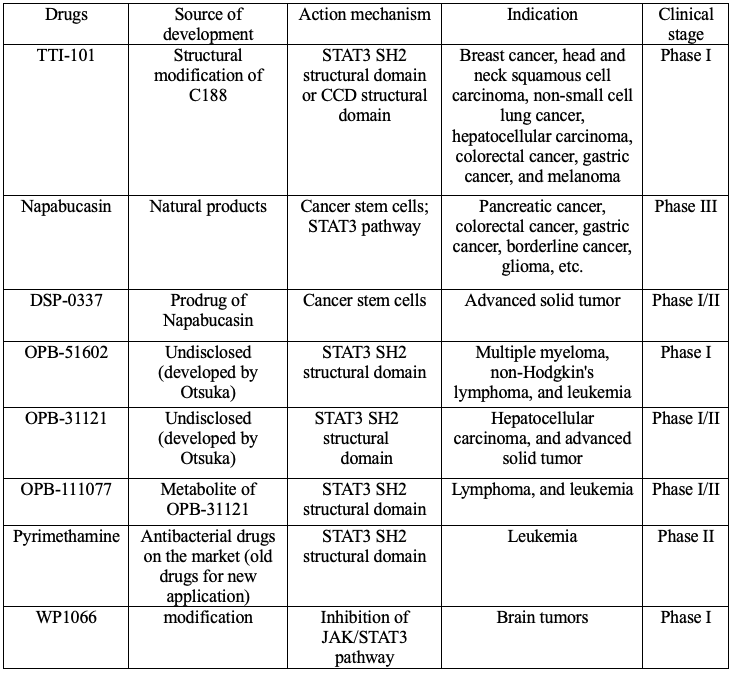PharmaSources/YuntianAugust 11, 2021
Tag: STAT3 , Antitumor Drugs , Tumor
STAT3 is a major member of signal transduction and activating transcription factor (STAT). According to some studies, it is verified that STAT3 can regulate the growth cycle and immune response of cells. It also has high expression in most tumors and is closely pertinent to prognosis. Therefore, many researchers of drug development have been developing targeted drugs for STAT3. At present, many drugs have been in the clinical trial and there are good responses, while there are much more STAT3 inhibitors under preclinical development. Therefore, the drug research and development of targeting STAT3 is also deemed as the next "outlet" of antitumor drugs with most attentions.
From the aspect of its structure, STAT3 protein consists of 770 amino acids and has six structural domains: TAD, DBD, LD, SH2, NTD and CCD. These six structural domains play their own functions respectively in functional regulation. Among them, amino acid residues Y705 and S727 of TAD are phosphorylation sites, which is the main approach to activate STAT3. DBD is responsible for binding to specific DNA sequences. LD can connect the structural domain DBD to SH2. SH2 affects the formation of STAT3 dimerization. NTD affects the binding of STAT3 dimer into nucleus and DNA. While CCD is mainly responsible for attracting STAT3 to bind to receptors. Among these six structural domains, SH2 contains three binding pockets: pY, hydrophobic pY+1 and pY-X, which is the key targeting domain of drug development in the current.
STAT3 can regulate the occurrence and development of tumors and its main mechanisms include: a. accelerating tumor dryness and proliferation of tumor stem cells; b. anti-apoptosis, increasing Bcl-xL, Mcl-1, Bcl-2 and other proteins; c. accelerating tumor metastasis and inducing the expression of matrix metalloproteinases (such as MMP-1, MMP-2 and MMP-9); d. promoting immune escape: reducing proinflammatory cytokines/chemokines.
Due to the pivotal role of STAT3 in regulating the occurrence and development of tumor, the drug development of targeting STAT3 has increasingly become one of the major research hotspots in recent two decades. Up till now, it has been reported that many compounds have STAT3-related pathway to inhibit activities and many drugs and medical supplies products have been in the clinical trial.

Table STAT3 Inhibitor in Clinical Stage
Figure 3 shows many STAT3 inhibitors under clinic trial, including TTI-101, Napabucasin, DSP-0337, etc. From the aspect of molecular structure, these drugs can be divided into benzothiophenes, sulfonamides, flavonoids, quinones, terpenoids, etc. The development sources include structural modification, natural medicines, old drugs for new application, etc. The action mechanisms include specific binding to of STAT3 structural domain, inhibiting STAT3-related pathway and tumor stem cells, etc. The indications of these drugs include liver cancer, colorectal cancer, melanoma, leukemia, etc. All these are enough to reflect the diversification of STAT3 inhibitor development and clinical application.
Up to mow, the development of STAT3 targeted drugs has entered the stage of deep development. Although there are no related drugs on the market, there is still a promising application.
In the future, the drug development of targeting STAT3 will attract increasing attentions and new technologies of drug development, such as PROTAC technology, will be continuously introduced. PROTAC is a technology of protein degradation. STAT3-PROTAC can not only inhibit the function of STAT3, but also directly degrade STAT3. It has great advantages in overcoming tumor drug resistance.
At present, there is a new trend of antitumor drug development at home and abroad. As one of the main hotspots in antitumor drug development, the research of targeting STAT3 has attracted increasing attentions, which has encouraged drug research and development personnel to invest more energy in this field. It is believed that more excellent STAT3 targeted drugs will be in the clinical trial in the future, benefiting many tumor patients.
Recent Update on Development of Small-Molecule STAT3 Inhibitors for Cancer Therapy: From Phosphorylation Inhibition to Protein Degradation,2021.
Yuntian, Ph.D. in medicinal chemistry, is mainly engaged in small molecule drug research, especially good at small molecule drug synthesis process and later stage drug development research. He has completed the synthesis and activity evaluation of multiple anti-cancer drug molecules.


Contact Us
Tel: (+86) 400 610 1188
WhatsApp/Telegram/Wechat: +86 13621645194
Follow Us:




 Pharma Sources Insight January 2025
Pharma Sources Insight January 2025


